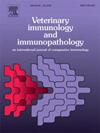Characterization of genital system inflammatory response in female dogs naturally infected with Leishmania infantum*
IF 1.4
3区 农林科学
Q4 IMMUNOLOGY
引用次数: 0
Abstract
The genital system of female dogs with visceral leishmaniasis (VL) commonly shows lesions on the external genitalia (vulva and vagina). This study aimed to evaluate the inflammatory response in segments of the reproductive tract of female dogs naturally infected with Leishmania infantum, and to correlate these findings with hormonal status (high or low progesterone levels), local parasitism, and local inflammatory infiltrate immunophenotype. Sixteen unspayed, non-pregnant adult female dogs naturally infected with L. infantum, without any other disease, were used. Animals were divided into two groups: G1 (n = 5, high-progesterone phase) and G2 (n = 11, low-progesterone phase). Parasite presence and the immunophenotype of leukocytes infiltrating the genital system (CD3, CD4, CD8, and MCA874) were determined by immunohistochemistry. Chronic inflammatory infiltrate was the predominant lesion and was mainly found in the vulva and vagina. Internal genitalia segments (cervix, uterus, ovary) presented fewer lesions. Animals of G1 group exhibited higher number of immunolabeled parasites in the internal segments of the reproductive tract and of cells positive for CD3 (T lymphocytes) and MCA874 (macrophages) than G2 group. There was no difference for CD4 and CD8 between groups. However, multivariate analysis showed positive correlations with T lymphocyte subtypes, macrophages, and parasite presence in different segments of the reproductive tract of G1 animals. Leukocyte population and number of parasitized cells in the reproductive tract increased with escalating progesterone levels (G1 group), suggesting that estrus and diestrus stages are most favorable to infection maintenance.
自然感染幼年利什曼原虫的母犬生殖系统炎症反应的特征*
患有内脏利什曼病(VL)的母狗的生殖系统通常在外生殖器(外阴和阴道)上显示病变。本研究旨在评估自然感染婴儿利什曼原虫的母狗生殖道部分的炎症反应,并将这些发现与激素状态(高或低孕酮水平)、局部寄生和局部炎症浸润免疫表型相关联。16只未绝育、未怀孕的成年母狗自然感染了婴儿乳杆菌,没有任何其他疾病。将动物分为两组:G1组(n = 5,高孕酮期)和G2组(n = 11,低孕酮期)。通过免疫组织化学检测寄生虫的存在和浸润生殖系统白细胞的免疫表型(CD3、CD4、CD8和MCA874)。慢性炎症浸润是主要病变,主要见于外阴和阴道。内生殖器(子宫颈、子宫、卵巢)病变较少。G1组动物生殖道内段免疫标记的寄生虫数量和CD3 (T淋巴细胞)和MCA874(巨噬细胞)阳性细胞数量均高于G2组。各组间CD4和CD8水平无差异。然而,多变量分析显示,G1动物生殖道不同节段的T淋巴细胞亚型、巨噬细胞和寄生虫的存在正相关。生殖道内白细胞数量和被寄生细胞数量随着孕酮水平的升高而增加(G1组),提示发情期和退情期最有利于感染维持。
本文章由计算机程序翻译,如有差异,请以英文原文为准。
求助全文
约1分钟内获得全文
求助全文
来源期刊
CiteScore
3.40
自引率
5.60%
发文量
79
审稿时长
70 days
期刊介绍:
The journal reports basic, comparative and clinical immunology as they pertain to the animal species designated here: livestock, poultry, and fish species that are major food animals and companion animals such as cats, dogs, horses and camels, and wildlife species that act as reservoirs for food, companion or human infectious diseases, or as models for human disease.
Rodent models of infectious diseases that are of importance in the animal species indicated above,when the disease requires a level of containment that is not readily available for larger animal experimentation (ABSL3), will be considered. Papers on rabbits, lizards, guinea pigs, badgers, armadillos, elephants, antelope, and buffalo will be reviewed if the research advances our fundamental understanding of immunology, or if they act as a reservoir of infectious disease for the primary animal species designated above, or for humans. Manuscripts employing other species will be reviewed if justified as fitting into the categories above.
The following topics are appropriate: biology of cells and mechanisms of the immune system, immunochemistry, immunodeficiencies, immunodiagnosis, immunogenetics, immunopathology, immunology of infectious disease and tumors, immunoprophylaxis including vaccine development and delivery, immunological aspects of pregnancy including passive immunity, autoimmuity, neuroimmunology, and transplanatation immunology. Manuscripts that describe new genes and development of tools such as monoclonal antibodies are also of interest when part of a larger biological study. Studies employing extracts or constituents (plant extracts, feed additives or microbiome) must be sufficiently defined to be reproduced in other laboratories and also provide evidence for possible mechanisms and not simply show an effect on the immune system.

 求助内容:
求助内容: 应助结果提醒方式:
应助结果提醒方式:


